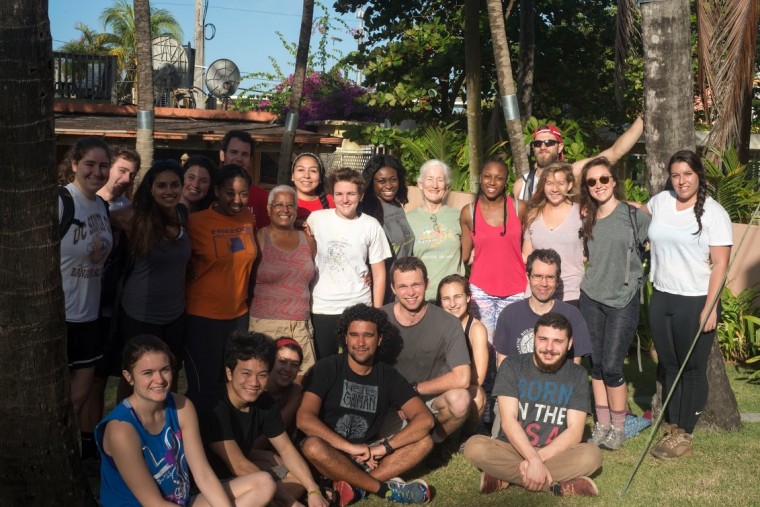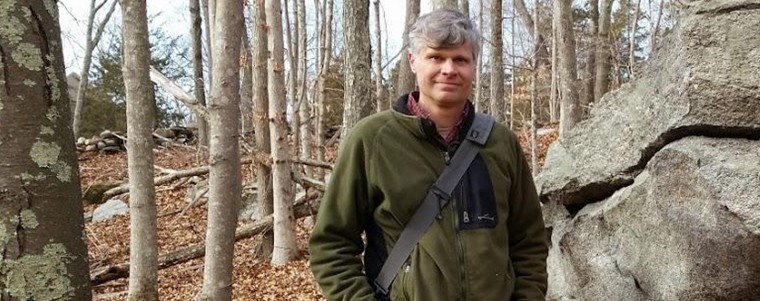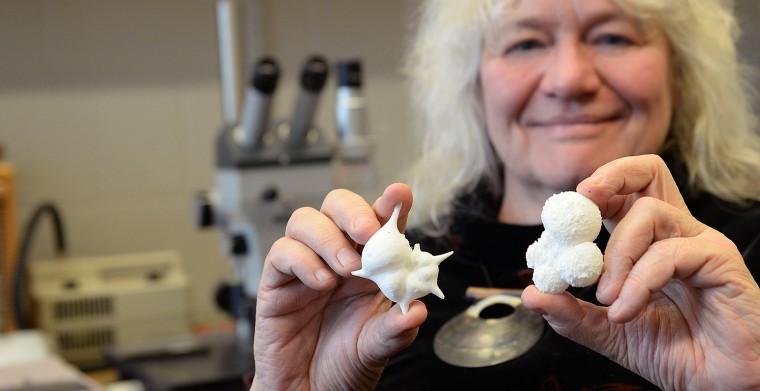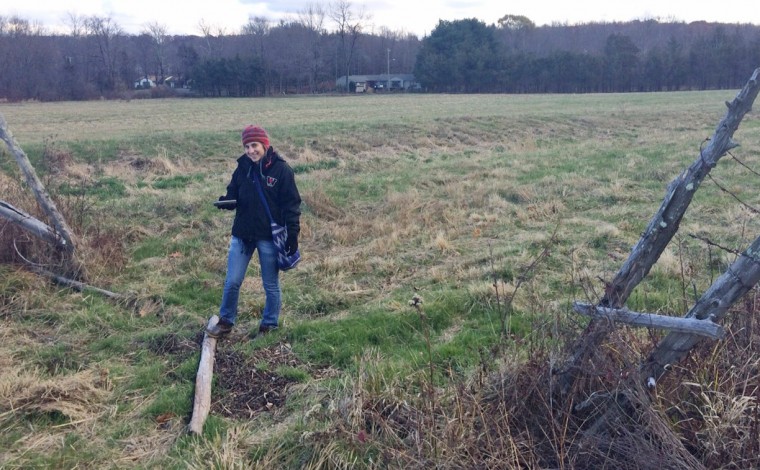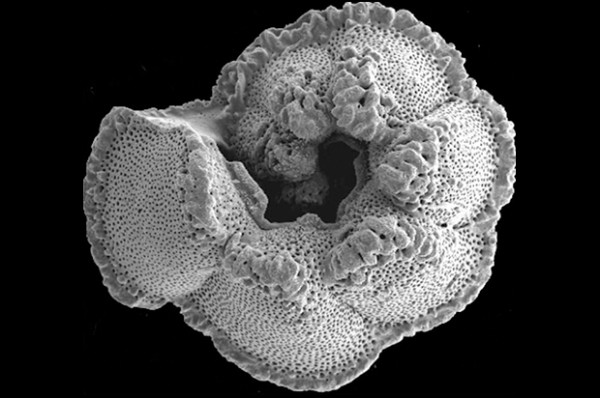Phil Resor, associate professor of earth and environmental sciences, and Gus Seixas '10 are co-authors of "Constraints on the evolution of vertical deformation and Colorado River incision near eastern Lake Mead, Arizona, provided by quantitative structural mapping of the Hualapai Limestone," published in the February 2015 issue of Geosphere, Vol. 11, pages 31-49. The paper includes research from Seixas's honors thesis at Wesleyan. In this study, the authors quantify the structural geometry of Hualapai Limestone, which was deposited in a series of basins that lie in the path of the Colorado River. The limestone was deformed by by a fault pair…
This semester, 21 senior earth and environmental science majors in the Senior Field Research Project (EES 398) course traveled to Puerto Rico to develop their research, data collection, analytical and presentation skills. As part of the EES Department's capstone course sequence, students are required to participate in a series of student-designed research projects. From Jan. 12-19, students performed independent research in the field. "The overarching spirit is to have students participate in the full arc of a research project: from the design all the way to the presentation of the results," said Dana Royer, associate professor of earth and environmental sciences, associate professor…
Phillip Resor, associate professor of earth and environmental sciences, was recently interviewed on WNPR about an amazing part of Connecticut's geological history. According to the story, several hundred million years ago, Connecticut was in the middle of a massive continental collision, which formed the super continent Pangea and pushed up huge mountains. Deep beneath the earth, a borderland beneath the two continents formed. Today, geologists call it the Lake Char fault system; it runs along the I-395 corridor in southeastern Connecticut. Resor took WNPR reporter Patrick Skahill to East Haddam by Gillette Castle to walk along the banks of the Connecticut River, and showed him fine black…
#THISISWHY Research Professor Ellen Thomas grasps a glass-enclosed sample of hundreds of microfossils, each a white fleck of limestone barely visible to the human eye. "The first time students look at these they say, 'they all look the same to me,' but in reality, they are all have very different shapes," Thomas says. "Even under a microscope, it can be difficult for a new eye to see the differences, but each species has its own shape; some have a much more open, light structure because they lived floating in the oceans close to the surface. Others have denser shells and lived on the bottom of the ocean,…
Martha Gilmore, the George I. Seney Professor of Geology, and her former graduate student Patrick Harner MA ’13 are the co-authors of a paper titled "Visible–near infrared spectra of hydrous carbonates, with implications for the detection of carbonates in hyperspectral data of Mars," published in Icarus, Vol. 250, pages 204-214, April 2015. The paper suggests that hydrous carbonate minerals might be relevant on Mars. "We bought and made these unusual minerals in my lab and then took spectra of them to simulate what Mars orbiters might see. Carbonate minerals form in water on Earth (e.g., limestones), and are predicted for Mars, but…
Students from Introduction to Environmental Studies (E&ES 197) presented their final projects Dec. 11 in Exley Science Center. The Project Showcase involved 80 students informally presenting artists books, GIS story maps, children's stories, fictional journals and other creative explorations. “All projects are related to environmental issues in the Connecticut River,” said course instructor Kim Diver, visiting assistant professor of earth and environmental sciences. The project is associated with the Center for the Arts' Feet to the Fire initiative. Several Wesleyan scholars and staff volunteered their time to demonstrate artist books to the students including Kate TenEyck, art studio technician and visiting assistant professor of art;…
Five groups of students enrolled in the Geographical Information Systems (GIS) Service Learning Laboratory course E&ES 324 presented their semester-long research Dec. 1 in Exley Science Center. Fellow students, faculty, staff, community members and community partners attended the presentations.
Jim Greenwood, assistant professor of earth and environmental sciences, was awarded a Faculty Seed Research Grant from the Connecticut Space Grant Consortium, supported by NASA. The honor comes with a $6,000 award. Greenwood will use the grant to support his research on “D/H of ‘Dry’ Extraterrestrial Materials.” Understanding the distribution, delivery, and processing of volatiles in the solar system is of fundamental interest to planetary science. Volatiles influence a number of important properties of planetary bodies, such as the cooling, differentiation, volcanism, tectonism, climate, hydrosphere/atmospheres and especially habitability. Greenwood will use the award to develop a new state-of-the-art inlet system for the measurement…
Wesleyan faculty Joop Varekamp and Ellen Thomas are among the authors of a paper on rates of sea-level rise along the eastern U.S. seaboard titled "Late Holocene sea level variability and Atlantic Meridional Overturning Circulation," published in the journal Paleoceanography, Volume 29, Issue 8, pages 765–777 in August 2014. Varekamp is the Harold T. Stearns Professor of Earth Science, professor of earth and environmental sciences and professor of environmental studies. Thomas is research professor of earth and environmental sciences at Wesleyan, and also a senior research scientist in geology and geophysics at Yale University. Pre-20th century sea level variability remains poorly understood due to…
Sixty-six million years ago, a meteorite struck the Earth with enough force that the ensuing environmental changes, including floods, earthquakes, variable temperatures and light-obscuring dust clouds, possibly wiped out dinosaurs and other pre-historic life. Scientists believe this opened a path for mammals, and ultimately humans, to evolve. A new study by Dana Royer, associate professor of earth and environmental sciences, and colleagues from the University of Arizona and the Denver Museum of Nature and Science suggests that the chaos in the wake of the space rock's impact changed the Earth's plant life as well. Deciduous plants survived and flourished to a…
Dana Royer, associate professor of earth and environmental sciences, is the co-author of “Plant Ecological Strategies Shift Across the Cretaceous-Paleogene Boundary,” published in PLOS Biology on Sept. 15. The study reveals that a meteorite that hit Earth 60 million years ago – and may have led to the mass extinction of the world’s dinosaur population – also led to a shift in the landscape of plants, particularly deciduous plants. Royer and his colleagues showed how they applied bio-mechanical formulas to fossilized leaves of flowering plants dating from the last 1.4 million years of the Cretaceous period and the first 800,000 of the Paleogene. Read more about…
Philip Resor, associate professor of earth and environmental sciences, is taking his knowledge of petroleum down under. Between June 18-26, Resor, a Distinguished Lecturer for the American Association of Petroleum Geologists (AAPG), is delivering six lectures in Australia. The talks are geared toward members of the Petroleum Exploration Society of Australia (PESA) and a general petroleum industry audience. While abroad, Resor will speak on "Syndepositional Faulting of Carbonate Platforms" and "Revisiting the Origin of Reverse Drag." He'll be lecturing in Melbourne, Adelaide, Perth, Brisbane, Sydney and Canberra. A specialist in structural geology, Resor's work integrates field mapping, remote sensing, and numerical modeling to better understand the…


